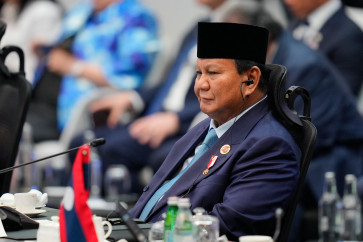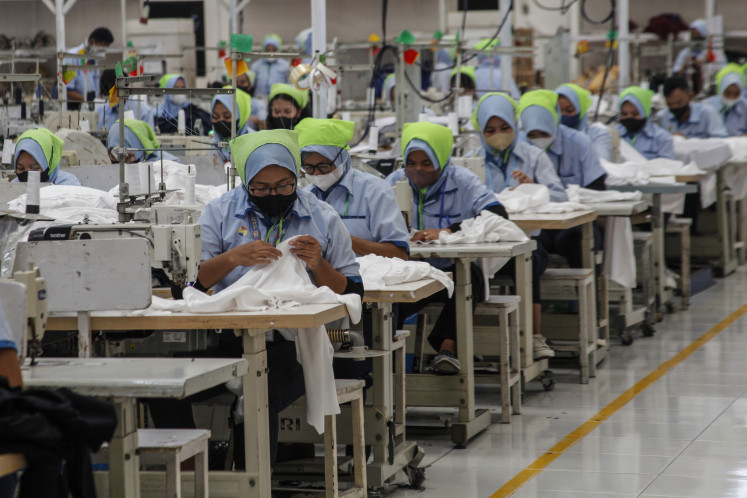Popular Reads
Top Results
Can't find what you're looking for?
View all search resultsPopular Reads
Top Results
Can't find what you're looking for?
View all search resultsWidjojo Nitisastro and changes to development paradigms
Widjojo Nitisastro is a humble man, not well known outside his circle
Change text size
Gift Premium Articles
to Anyone
W
idjojo Nitisastro is a humble man, not well known outside his circle. However, quietly, he made a very important contribution to the Indonesian economy, as the main architect of the Indonesian economy at the beginning of the New Order in 1966.
A book of his notes, Pengalaman Pembangunan Indonesia. Kumpulan Tulisan dan Uraian Widjojo Nitisastro (Indonesian Development Experiences. A Collection of Writing and Notes of Widjojo Nitisastro), was launched in Jakarta on Jan. 14.
Times change, and so do issues and challenges. In turn, paradigms must change too. History shows that crises often force us to adopt paradigm changes. Unfortunately, not all crises result in paradigm changes. Without paradigm changes, deeper and longer crises may occur. This phenomenon is also observed in the history of economic ideas.
During the 1930s, J. M. Keynes revolutionized the teaching of economics. After being quantified by Samuelson and friends, his teachings became what is now famously known as "macro-economics", recognized and adopted all over the world.
At that time, the world was in the grips of the Great Depression. The economies of richer countries, such as the United States and those in western Europe, had reached rock bottom. Policymakers expected the market to automatically correct itself from the severe downturn. Mainstream economic theory at the time held that a heating economy would automatically cool, and that a sinking economy would recover by itself once it hit bottom. Unfortunately, the automatic recovery never happened; rather, the situation became worse and worse.
At that time, Keynes introduced his radical idea of government intervention into the market. The government had to create demand by increasing government spending. This is what is now commonly referred to as "stimulus".
It was not easy for Keynes to promote his ideas. He had to face angry reactions from mainstream economists and policymakers. His ideas were only recognized and carried out once they had the full political support of Franklin D. Roosevelt, then president of the United States.
As a consequence of the interventions Keynes recommended, the US and world economies recovered. The world followed the new paradigm adopting a combination of market mechanisms and government intervention to stabilize markets.
However, not all countries took on Keynes' ideas. Countries with socialist/communist orientation were among those that most likely did not to follow suit. They believed the government knew best and that the economy should be under its full control. Price was not used as an indicator in the allocation of goods and services or in factors of production. They did not believe in the role of the market. The Soviet Union (before it fell apart) was a good example of such a system.
Indonesia, before 1966, also ignored the role of market mechanisms. The government did not believe in economic analysis. At that time, politics was the prima donna.
The then Indonesian president, Sukarno, even proudly said he was illiterate in economic analysis. Coupled with the war against the US, the UK and neighboring countries (Malaysia and Singapore), Indonesia's economic situation in the early 1960s was chaotic, and experienced hyperinflation. The average price in December 1965 was about seven times that in December 1964.
Then, into this picture, stepped Widjojo Nitisastro, to tell the government to change its economic paradigm. During his inauguration as a professor of economics at the University of Indonesia, on Aug. 10, 1963, Widjojo made a speech titles "Analisa Ekonomi dan Perencanaan Pembangunan" (Economic Analysis and Development Planning) He proposed a change of development paradigm, which would see economic analysis incorporated into policy making, to the then president (who did not appreciate economic analysis).
Politically, Widjojo Nitisastro was also in a very unfavorable position. He and several of his friends at the School of Economics had obtained a postgraduate education in the United States, a country Sukarno condemned strongly.
What Widjojo did was in fact similar to what Keynes had done - proposing a combination of market mechanisms and government intervention, rather than a total abandonment of the market or complete reliance upon it.
And, similar to Keynes' experiences in attempting to promote his ideas, Widjojo only saw his ideas taken up in 1966, once Soeharto had taken over the leadership from Sukarno. Soeharto provided Widjojo with full political support for the implementation of his ideas. Indeed, the ideas of Widjojo and his friends at the School of Econo-mics, University of Indonesia, clearly marked the development planning paradigm for the beginning of the New Order, in 1966.
Widjojo's ability and courage to introduce his ideas had begun earlier. His dissertation, written in the late 1950s and early 1960s, was on the relationship between migration, population growth and economic development in Indonesia. Following his dissertation, Widjojo published the now legendary Population Trends in Indonesia. To the current generation of students of demography, the analysis in this book may not seem like anything special. However, Widjojo Nitisastro produced the book at a time when there was a scarcity of demographic data and analytical capabilities for developing countries. He produced his own statistics. Indeed, he was the first Indonesian demographer.
Then, with the support and trust of Soeharto to prepare the national development plan, Widjojo's demographic work was further developed by Demographic Institute at the School of Economics, of which he was one of the founders. The demographic data and analysis then became an important foundation to be used to prepare Indonesia's development plans.
Of course, current issues and challenges are vastly different from those of Keynes and Widjojo Nitisastro. However, there is at least one thing in common: we need new development paradigms to be able to exit from crises and not to fall victim to similar, but worse, deeper, crises.
Many crises have affected the world (including Indonesia), the latest being global in nature. Without fundamental changes to world development paradigms, more and deeper crises may occur.
Will there be new development paradigms and will the political elite and mainstream economists support such new paradigms? As world issues have become more complex, another difference between the ideas of Keynes and Widjojo Nitisastro is that now not only economists but also non-economists should be involved in the formulation of new paradigms. An interdisciplinary approach is really essential in the creation of a new development paradigm.
This book is worth reading. There are many more things we can learn from it.
Aris Ananta is senior research fellow at the Institute of Southeast Asian Studies, Singapore










